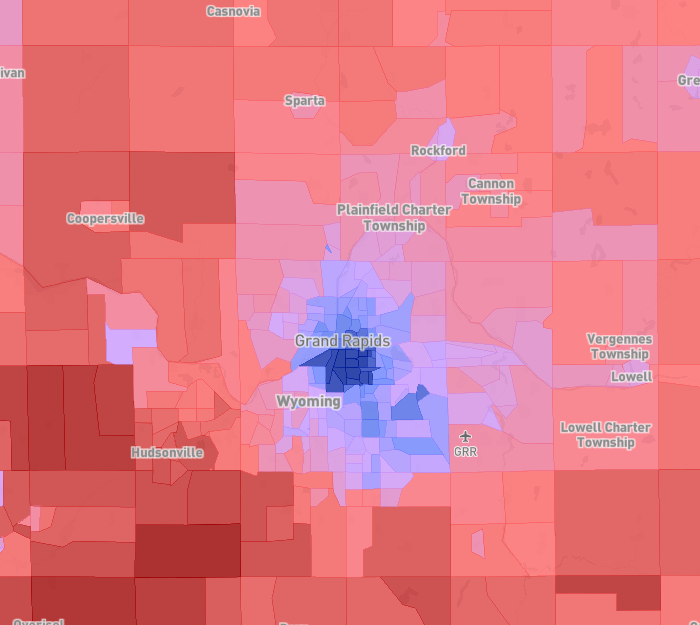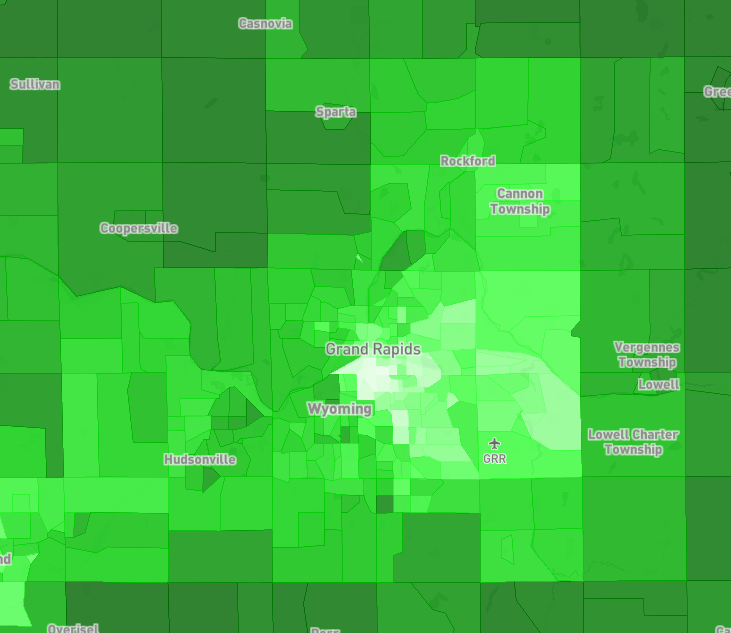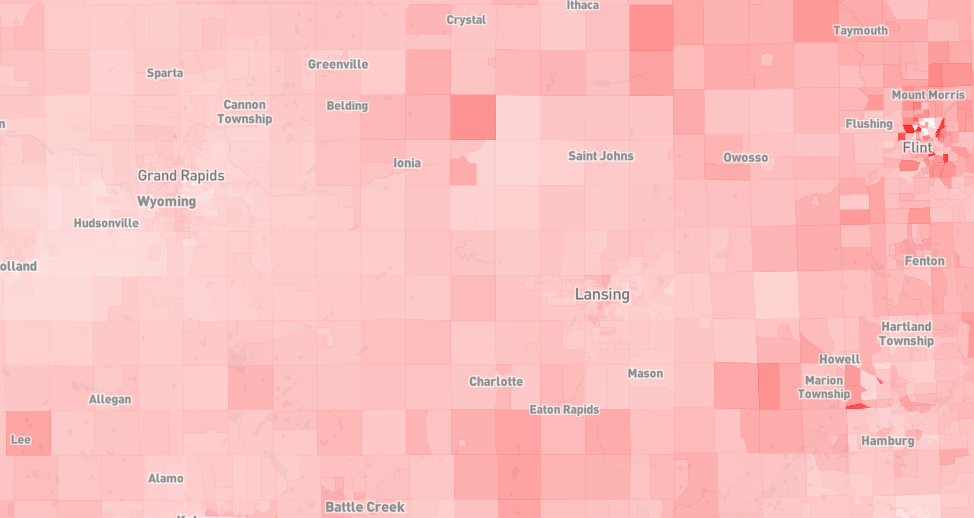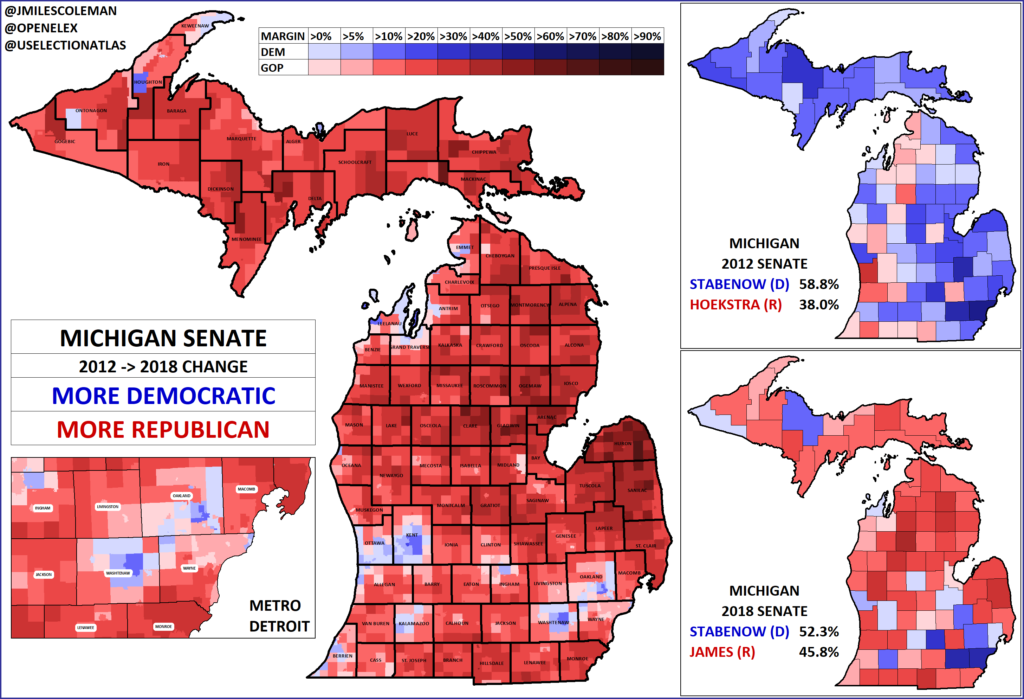President Donald Trump carried Michigan by less than 12,000 votes in 2016, and did so mainly on a massive shift among whites without a college degree. His performance in suburban areas, particularly those populated mostly by whites with a college degree, dipped notably from Mitt Romney’s, and this held true throughout the state. He also benefited from a drop in participation from minority voters, one that isn’t likely to repeat next year. So how does he manage to win its electoral votes next year?
Trump’s potential re-election, or loss, is a margins game. For that second term, he needs to win 1) a sizable share of the non-college educated white vote, equal or greater than last time and/or 2) a greater share of the suburban vote he struggled with (and polling suggests he still struggles with) and/or 3) a greater share of black, Hispanic and Asian votes. The President will be back in Michigan next week for a campaign rally. For him, visiting an area like Grand Rapids make sense, particularly if he can attract suburban voters due east of the city proper. The metro area voted for Trump over Clinton in 2016:

Western Michigan has been a Republican stronghold for decades. Kent County, its most populated and home to Grand Rapids, has been red since my Dad could start voting (he’s really old, sorry Dad). Kent narrowly voted for then-Senator Barack Obama in 2008, but reverted to form and voted for Mitt Romney in 2012. Then-Governor Rick Snyder comfortably carried it in his re-election two years later. But Donald Trump barely carried it, and the suburbs within shifted towards Hillary Clinton, as areas with similar demographics had throughout the state, as you can see in the shift map below:

When you look at the demographics of Michigan, education, particularly race and education, prove a strong predictor for Trump’s performance. It was certainly true in Grand Rapids. Keep the above maps of overall performance and shift from 2012 in mind when you look at the concentration of whites with college degrees:

And whites without them:

Trump’s fortunes and misfortunes in the Grand Rapids area were highlighted early on in 2016, with his narrow primary win. Ted Cruz and John Kasich both won more precincts in the 2016 election in the metro Grand Rapids area than the President. Notice the decline in his primary vote share in the west:

One could argue his visit to Western Michigan is meant to solidify Republican Party support in more Trump-skeptical parts, and it wouldn’t be a bad strategy: there’s an overlap between suburban white voter share and that chunk of the party, and with such a very narrow win the last time, any persuasion efforts in historically red areas would be expected.
A question emerged shortly after the Presidential election: was this drop in the suburbs, particularly among whites with college degrees, limited to Trump? In the same cycle, Senators Pat Toomey and Rob Portman did well with these voters in their re-election. Many Republicans won re-election to the House despite their districts pulling for Clinton. That question was answered last year with a resounding “no”. Even as Republican Senatorial candidate John James gave Debbie Stabenow her toughest re-election fight ever, winnowing her previous margin by two-thirds- he outright lost Kent County:

Had Trump lost Kent like James, it’s doubtful he would have carried the state at large. The areas that shifted furthest within the county- the suburbs east, south and west- all saw declines from Romney to Trump, so it certainly would be an area of concern for the President’s campaign team.
Republicans in the post-2018 period have had to examine their recent misfortunes in suburbia and former strongholds carefully as they plan their attempts to retake the House, defend their Senate majority, and, for Trump, earn a second term in the White House.
Our own Miles Coleman, who made our 2018 graphics, has a wonderful examination of the Senate race and the Gubernatorial one, which you can read here and here respectively.
This article was modified with updated graphics using our precinct-level API of Presidential primary results, general election results, and demographic data.